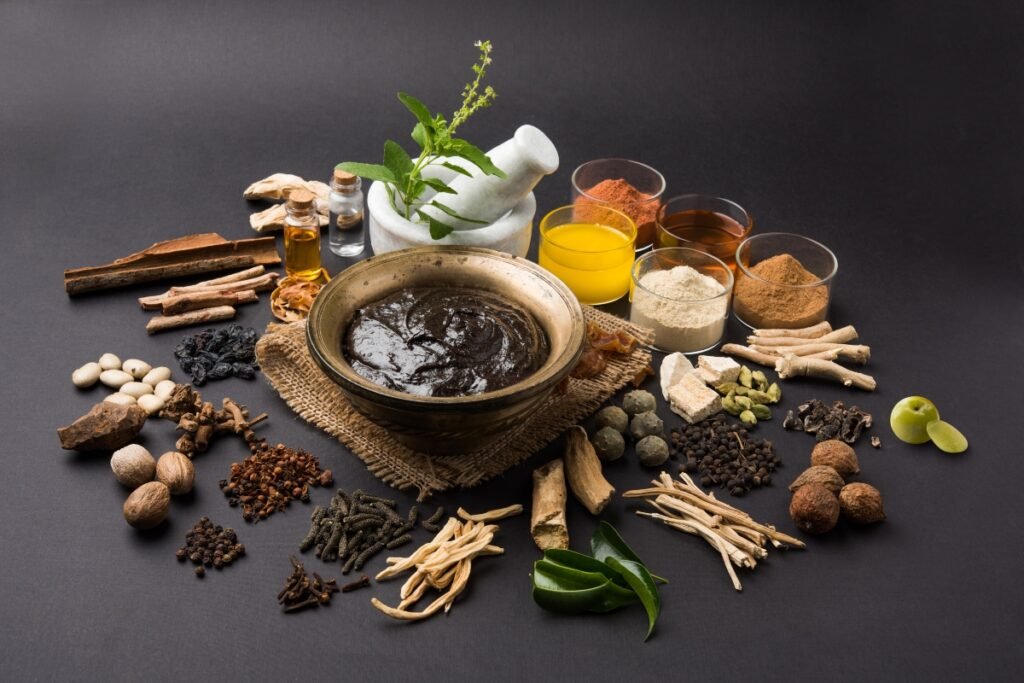For centuries, Ayurveda has offered profound insights into health and well-being. At its heart lies a sophisticated understanding of natural remedies, and among the most potent and widely used formulations are Ayurvedic kashayams. These powerful herbal decoctions, often overlooked in the modern wellness landscape, hold a wealth of therapeutic potential.
But what exactly are they, and what is the science behind Ayurvedic kashayams that makes them so effective? In this blog, we’ll delve deep into the world of kashayams, exploring their historical and scientific significance, their myriad kashayam benefits, and even how you can prepare them in your own home.
What Is Kashayam in Ayurveda?
Kashayam is a classical Ayurvedic liquid formulation prepared by boiling medicinal herbs in water to extract their active principles. It is made using cleaned, dried, chopped, powdered, or coarsely powdered raw drugs. They are typically bitter, astringent, or pungent in taste and are consumed fresh or preserved for short durations.
As per classical Ayurvedic texts, Kashayam is prepared by boiling the prescribed herbs in 16 times the quantity of water and reducing it to one-eighth or one-fourth of the original volume. This decoction is then strained using a clean cotton cloth, resulting in a potent and bioavailable liquid extract.
Kashayam Meaning and Its Historical Roots
The term Kashayam in Ayurveda is often used interchangeably with Kwatha, Shruta, and Niruha, referring to herbal decoctions. Although “Kashayam” typically refers to the astringent taste (Kashaya Rasa), its etymological meaning is derived from Sanskrit roots: ‘Ka’ represents Kaya (the body), ‘Sha’ indicates Sharir kriya (bodily functions), and ‘Ya’ denotes regulation. Thus, Kashaya means the one that helps regulate body functions or maintain equilibrium.
Kashayam belongs to the category of Panchavidha Kashaya Kalpana, which are the five fundamental preparations in Ayurvedic pharmaceutics: Swarasa (fresh juice), Kalka (paste), Kwatha (decoction), Hima (cold infusion), and Phanta (hot infusion). Rooted in ancient practices described in all classical Ayurvedic texts like the Charaka Samhita and Ashtanga Hridaya, Kashayam is valued for its ability to extract water-soluble active principles from herbs. This method enhances the bioavailability of medicinal ingredients, making Kashayams a powerful formulation for managing both acute and chronic conditions.
The Ayurvedic Science Behind Kashayams
Kashayams are formulated based on Ayurvedic principles that aim to balance the three doshas (Vata, Pitta, and Kapha) by acting on specific tissues (dhatus) and body channels (srotas). The decoction process enhances the extraction of water-soluble phytochemicals, ensuring the potency and efficacy of the formulation.
Because of their liquid nature, Kashayams are rapidly absorbed, offering quicker therapeutic effects compared to other forms like powders or tablets. Depending on the ingredients used, they can work as digestive stimulants (Deepana), anti-inflammatories (Shothahara), or rejuvenators (Rasayana), making them highly adaptable in Ayurvedic clinical practice.
Read: Ayurvedic Arishtas
Kashayam Benefits Backed by Traditional & Modern Evidence
Since ancient times, kashayam has been known for its immense health benefits. The benefits of Ayurvedic decoctions include:
- Improves Digestive Health: Formulations containing herbs like ginger (Zingiber officinale), cumin (Cuminum cyminum), and other herbs are excellent for improving digestion, kindling digestive fire, alleviating bloating, regulating bowel movements, and supporting overall gut function.
- Enhances Respiratory Health: Kashayams with herbs like vasa (Adhatoda vasica) and tulsi (Ocimum sanctum) help support respiratory health, clear congestion, and soothe the airways and are beneficial in managing respiratory conditions such as cough, cold, asthma, and bronchitis.
- Boosts Natural Immunity: Kashayams, rich in immune-modulating herbs including guduchi (Tinospora cordifolia) and amalaki (Emblica officinalis), are traditionally used to improve the body’s natural defense mechanisms and fight against infections.
- Supports Musculoskeletal Health: Kashayam with herbs such as turmeric (Curcuma longa) and shallaki (Boswellia serrata) possesses anti-inflammatory and analgesic properties that help reduce pain and inflammation, improve joint flexibility, and enhance overall joint health.
- Detoxification and Skin Health: Kashayam containing herbs such as Manjistha helps eliminate toxins, supports liver function, purifies the blood, and improves skin health.
- Helps Reduce Stress: Formulations contain nervine tonics help calm the nervous system, reduce stress, and promote mental clarity.
How to Prepare Kashayam at Home
While many specialized kashayams are best prepared by experienced Ayurvedic practitioners, a basic kashayam preparation for general wellness can be done at home. Here’s a simple guide:
- Select the dried herbs according to your needs (dried, powdered, or coarsely powdered).
- For a basic kashayam, a common ratio is 1 part dried herbs to 16 parts water. For example, if you use 1 tablespoon of herbs, use 16 tablespoons of water.
- For harder roots and barks, soaking the herbs in water for a few hours or overnight can help in better extraction.
- Place the herbs and water in a clean vessel. Bring to a boil, then reduce the heat to a simmer.
- Simmer gently until the liquid reduces to 1/8th of its original volume.
- Strain the liquid using a fine-mesh sieve or cotton cloth, discarding the herbs.
- Consume the kashayam warmly. You can add a little honey or jaggery for taste, though traditionally it’s often consumed plain.
Always consult a qualified Ayurvedic practitioner before self-prescribing kashayams, especially for chronic conditions, as individual constitution and specific health needs play a crucial role in determining the right formulation and dosage.
FAQs
1. What is the science behind Ayurvedic medicine?
Ayurveda is a holistic system balancing body and mind based on universal principles like the Panchamahabhutha (five elements) and Tridoshas (three fundamental energies). It involves understanding individual constitution (Prakriti) and imbalances (Vikriti) to restore harmony through natural remedies, diet, lifestyle, and therapies. Its efficacy lies in a personalized, root-cause approach and the synergistic action of multi-herb formulations.
2. How does kashayam work?
Kashayam works by extracting water-soluble active compounds from medicinal herbs through boiling and reduction. These potent compounds are readily absorbed, interacting with the body’s systems to balance doshas, reduce inflammation, boost immunity, enhance digestion, and improve overall health.
3. Is there scientific proof of Ayurveda?
Yes. Numerous studies have validated herbs used in Ayurveda for their therapeutic properties, including antioxidant, antimicrobial, and adaptogenic effects. While more randomized trials are needed, the World Health Organization (WHO) has recognized Ayurveda as a traditional medicine system.
4. Does kashayam have side effects?
When used under professional guidance, kashayams are generally safe. However, like any potent medicine, improper use, excessive doses, or unsuitable formulations can lead to side effects such as digestive upset, allergic reactions, or interactions with other medications. Consulting a qualified Ayurvedic practitioner is important for determining proper dosage and formulation, minimizing risks, and maximizing benefits.
5. Does Kashayam cause weight loss?
Some kashayams can support weight management by improving digestion, boosting metabolism, and aiding detoxification, especially those targeting Kapha dosha or fat metabolism. However, kashayam is not a standalone solution for weight loss. It should complement a holistic approach, including a balanced diet, regular exercise, and lifestyle changes.
6. What are the five types of fundamental medicinal preparations in Ayurveda?
The five fundamental preparations in Ayurvedic pharmaceutics are Swarasa (fresh juice), Kalka (paste), Kwatha (decoction), Hima (cold infusion), and Phanta (hot infusion).







